Introduction
Scutellaria species (spp.), commonly known as skullcap, are perennial, herbaceous plants frequently classified as wildflowers. Approximately 350 species have been identified in temperate regions throughout the world. In Florida, 13 species have been identified, 11 of which are native to the state. Scutellaria spp. are prized for their unique seed stalks and blue to purple flowers (Figures 1 and 2). The name Scutellaria is derived from the Latin word "scutella," which translates to "little dish," referring to the structure of the calyx (Figure 2). The calyx protrudes over the base of the flower, resembling a cap or helmet, hence the common name skullcap. In Florida, Scutellaria spp. grow in diverse environmental areas ranging from uplands, seasonally flooded, and ruderal areas.
Scutellaria spp. are cultivated for both their ornamental and medicinal value. Scutellaria baicalensis, or Baikal skullcap, has been utilized for centuries in traditional Chinese medicine to address a variety of health conditions. In the United States, Scutellaria lateriflora, or American skullcap, is a popular herb cultivated and sold as a common ingredient in teas and is believed to have anxiolytic effects when consumed. Many cultivars of this genus are sold as ornamental plants given their aesthetically pleasing flower stalks, long season of blooming, and drought tolerance.
This EDIS publication is an overview of the genus Scutellaria and its medicinal and ornamental value, with a focus on Florida native species and economically significant species. It includes an overview of botanical characteristics, growth habits, and cultivation protocols of Scutellaria species. This publication is useful to commercial and residential growers and those interested in native and/or medicinal plant species.
Common name: Skullcap
Scientific name: Scutellaria spp.
Plant family: Lamiaceae
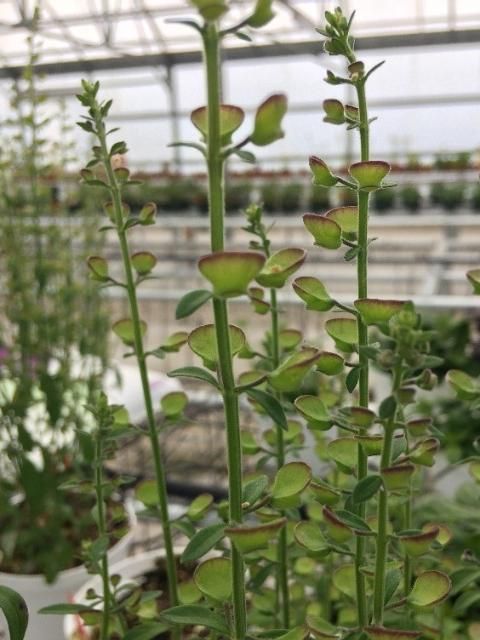
Credit: Amanda Morgan, UF/IFAS
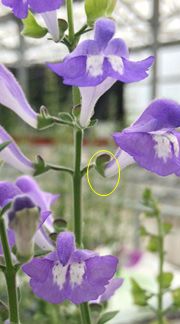
Credit: Amanda Morgan, UF/IFAS
Botanical Description
The genus Scutellaria is a member of the mint family and has the characteristic square stem seen in other Lamiaceae members. The blue to purple flowers are tubular, two-lipped, indeterminate, form on racemes, and begin blooming in spring and continue through fall. Leaves are opposite and commonly ovate, though leaf structure varies between species and can also vary depending on their position along the stalk. In Scutellaria integrifolia alone, leaves have four different structures ranging from crenate and deltoid to smooth and lanceolate from the base to the apex of the plant. Leaf color ranges from dark to lime green. Purple foliage is common in many Scutellaria species, and is a sign of anthocyanin content, which often accumulates under environmental stressors such as light intensity. Members of the Scutellaria genus have been reported to reproduce by both sexual and asexual methods (Miller 2001).
Scutellaria integrifolia, or Helmet skullcap, is the most widely observed species found in Florida, as it has been found growing naturally in 54 of the 67 counties. This species is a heavy seed producer, can readily reproduce and spread within landscape, and is commonly observed along roadsides and similarly disturbed, full-sun areas. This species can tolerate both wet and dry soil conditions. Scutellaria arenicola, or scrub skullcap, is the second most common species observed throughout Florida. It can be found in sand and scrub habitats and prefers well-drained soil environments. Nine other Florida native skullcap species can be found throughout the state; however, most have extremely limited ranges and are listed as endangered or threatened, such as S. floridana and S. havanensis.
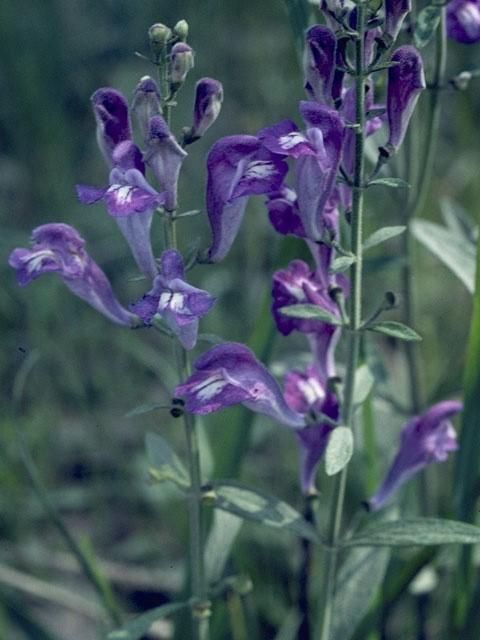
Credit: Bransford, W.D. and Dolphia, Wildflower Center Slide Library
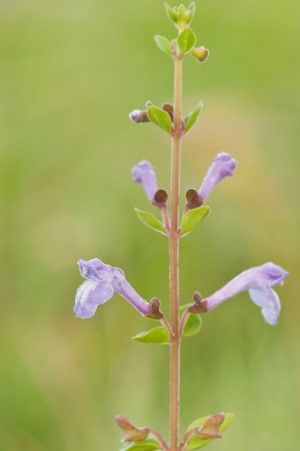
Credit: Keith A. Bradley, regionalconservation.org
Ethnobotanical Uses
Scutellaria baicalensis, or Huang Qin, is a valuable herb in eastern medicine. This species is native to Korea, China, Japan, Mongolia, and Russia. It is listed in the Chinese Pharmacopoeia and is prescribed to patients as an anti-inflammatory, antioxidative, and anti-thrombic agent (Shang et al. 2010). Dried roots of this species are encapsulated, typically combined with other beneficial herbs, and administered to patients. Numerous studies have suggested this herb should be further examined for its potential utilization in combination with, or as an alternative to, current cancer therapies (Zhang et al. 2003; Bonham et al. 2005; Scheck et al. 2006). While not recognized formally by the medical community in the US, American skullcap (Scutellaria lateriflora) is sold as a constituent in teas and extracts as an herb with anxiolytic effects. It has become a popular alternative to valerian root (Valeriana officinalis) and kava kava (Piper methysticum) (Awad et al. 2003). At least 35 species of skullcap have been analyzed for medicinal qualities, but S. baicalensis in Asia and S. lateriflora in the US remain at the forefront of commercial propagation (Morgan 2018).
Medicinal benefits of Scutellaria spp. are attributed to flavonoids present in vegetative and root tissue (Morgan 2018). The Chinese Pharmacopoeia states that medical grade skullcap should contain at least 9% baicalin, the main flavonoid constituent of the genus (Shang et al. 2010). In the US, skullcap is not regulated by the FDA and has no set standard market value. Nonetheless, skullcap containing high concentrations of flavonoids are sold at a premium, especially when certified organic (Similien et al. 2016).

Credit: Amanda Morgan, UF/IFAS
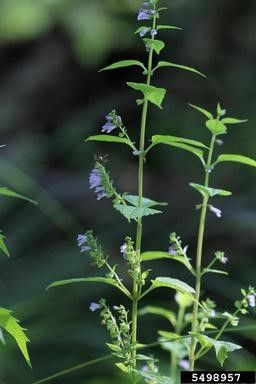
Credit: bugwood.org
Cultivation
USDA Hardiness Zone
Hardiness zone is dependent upon the Scutellaria species being cultivated. Scutellaria lateriflora, or American skullcap, naturally occurs in USDA hardiness zones 2b to 7b and is the most widely occurring species of Scutellaria in North America. Other species of Scutellaria have more limited ranges, such as S. integrifolia, which prefers zones 6b to 8a. (United States Department of Agriculture 2018).
Light Requirements
Light requirements will be specific to the species of Scutellaria being grown. Most species will perform best in full sun to partial shade. To maximize flower production, full sun is preferred.
Water Requirement
Water requirements vary among Scutellaria species; however, most are fairly drought-tolerant once established.
Fertilizer Requirement
Florida native species of Scutellaria have low fertilizer requirements. Once established in the landscape, little supplemental fertilization is required. To maximize flowering, low to medium rates of slow-release fertilizers should be applied according the manufacturer's recommendations.
Pests/Disease
There is no reported incidence of pests or disease among Scutellaria species being grown in a landscape setting. Aphid and whitefly have been observed when S. integrifolia, S. arenicola, and S. lateriflora have been cultivated in greenhouse environments. Powdery mildew was observed to occur on S. lateriflora when cultivated in a greenhouse in Apopka, Florida.
Production
Production techniques associated with Scutellaria spp. may vary depending upon how the plant is intended on being utilized. Although not commonly documented, several species of skullcap have been shown to easily germinate from seed or through rooted cutting techniques and include Scutellaria lateriflora, S. baicalensis, S. integrifolia, and S. arenicola. These species prefer a medium-drained substrate with about 30% bark and 50% peat. Field growth of Scutellaria spp. is also common, though reported production methods are limited to plants being grown for medicinal purposes.
When growing plants for ornamental purposes, medium rates of fertilizer should be utilized along with regular irrigation applications to help support development of flowers. When cultivated for medicinal use, environmental stress can be purposely induced to influence synthesis of flavonoids and result in higher production of medicinally active compounds. Flavonoids are believed to play a role in protection of plant cellular tissue, and have been shown to accumulate when plants experience environmental stress (Kumar and Pandey 2013). Medicinally cultivated Scutellaria species are therefore often subject to nutrient deficiencies, water stress, or high UV exposure to produce high plant stress conditions (Cao et al. 2012; Similien et al. 2016).
Conclusion
Scutellaria spp. are diverse and valuable for their status as both medicinal and ornamental plants. Both Scutellaria integrifolia and Scutellaria arenicola can be found throughout Florida and make unique and interesting landscape plants. Although specific commercial management practices do not exist for cultivation of Scutellaria spp. for medicinal use, production factors that induce plant stress have shown to increase production of medicinally active compounds. Research efforts conducted at the University of Florida support induction of plant stress to aid in flavonoid synthesis and production of medicinally active plant compounds in both Scutellaria integrifolia and Scutelaria arenicola.
References
Awad, R., J. T. Arnason, V. Trudeau, C. Bergeron, J. W. Budzinski, B. C. Foster et al. 2003. "Phytochemical and biological analysis of skullcap (Scutellaria lateriflora L.): a medicinal plant with anxiolytic properties." Phytomedicine. 10(8): 640‒649. doi: 10.1078/0944-7113-00374.
Bonham, M., J. Posakony, I. Coleman, B. Montgomery, J. Simon, and P. S. Nelson. 2005. "Characterization of chemical constituents in Scutellaria baicalensis with antiandrogenic and growth-inhibitory activities toward prostate carcinoma." Clin. Cancer Res. 11(10): 3905‒3914. doi: 10.1158/1078-0432.CCR-04-1974.
Cao, X. Y., F. L. Xu, W. L. Wang, J. Wang, S. H. Huang, and X. H. Zhang. 2012. "Responses of Scutellaria baicalensis Georgi yield and root baicalin content to the fertilization rates of nitrogen, phosphorus, and potassium." Ying Yong Sheng Tai Xue Bao = The Journal of Applied Ecology. 23(8): 2171‒2177.
Kumar, S., and A. K. Pandey. 2013. "Chemistry and biological activities of flavonoids: an overview." The Scientific World Journal. doi: 10.1155/2013/162750.
Miller, K. E. 2001. Scutellaria integrifolia L. Hyssop Skullcap. Framingham, MA: New England Plant Conservation Program.
Morgan, A. 2018. Effects of volumetric soil water content and fertilizer rate on growth and baicalin accumulation in two species of Scutellaria. J. of Hort. and For. 10(6):97-105. doi: 10.5897/JHF2018.0529
Scheck, A. C., K. Perry, N. C. Hank, and W. D. Clark. 2006. "Anticancer activity of extracts derived from the mature roots of Scutellaria baicalensis on human malignant brain tumor cells." BMC Complement. Altern. Med. 6(1): 27. doi: 10.1186/1472-6882-6-27.
Shang, X., X. He, X. He, M. Li, R. Zhang, P. Fan et al. 2010. "The genus Scutellaria an ethnopharmacological and phytochemical review." J. Ethnopharmacol. 128(2): 279‒313. doi: 10.1016/j.jep.2010.01.006.
Similien, A., D. A. Shannon, C. Wesley Wood, A. M. Rimando, B. W. Kemppainen, E. van Santen et al. 2016. "Shade, Irrigation, and Nutrients Affect Flavonoid Concentration and Yield in American Skullcap." Crop Sci. 56(3): 1213‒1224. doi: 10.2135/cropsci2015.03.0186.
United States Department of Agriculture, National Resources Conservation Service. 2017. "The PLANTS database." https://plants.usda.gov/core/profile?symbol=SCIN2
Zhang, D. Y., J. Wu, F. Ye, L. Xue, S. Jiang, J. Yi et al. 2003. "Inhibition of cancer cell proliferation and prostaglandin E2 synthesis by Scutellaria baicalensis." Cancer Res. 63(14): 4037‒4043.